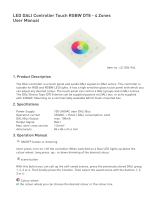
Installation Instructions
Santa Clara, CA 95050 © 2004 The Watt Stopper,
®
Inc.
DSS4-x
ezDALI Remote Scene Switch
Installation and Operation
The DSS4-x Remote Scene Switch is a component
of an ezDALI System. It allows occupants to recall
any one of up to four lighting scenes for a group
of lighting fixtures. It connects directly to the 2-
wire DALI bus to provide multiple-location switch-
ing of the four scenes created by the Group &
Scene Controller (DLCSS4-x).
The x suffix in the catalog number refers to button and
switchplate color:
2 = ivory, 4 = almond, 7 = white and 9 = grey.
A complete ezDALI system includes the following:
1. Group Controller (DLC) or Group & Scene
Controller (DLCSS))
2. Power Supply (DPS series)
3. Lighting fixtures equipped with DALI ballasts
Optional components in the system are:
4. Remote Scene Switch (DSS4) for use with Group &
Scene Controller (DLCSS)
5. Relay Module (DRM) to control non-DALI fixtures
6. Occupancy Sensor(s)
Operation
The Group & Scene Controller allows the user to
create four lighting scenes. For example, the lighting
levels of the fixture groups within a conference room
could be adjusted to create a lighting environment
suited to “PowerPoint Presentation,” “Meeting” or
“Reception.” Pressing a Scene button initiates a
command over the DALI bus to fade to that scene.
The ballast groupings and scenes are programmed
into the ballasts by the Group & Scene Controller
using push-button programming. The Remote Scene
Switch enables these scenes to be recalled and
monitored from multiple locations, providing 3-way
operation and true status indication.
The large Master button on the switch provides an
OFF/Restore function. Once the occupant has
selected the desired scene, pressing and releasing
the Master button will turn off the scene. Pressing and
releasing it again will restore the scene.
Before proceeding, read the instructions on the
following pages. If you have any questions, call
our Service Team at: 888-852-2778.
Features
• Digital control of up to 64 ballasts or relay modules
on a 2-wire DALI bus
•Powered from DALI bus with less than 5 mA current
draw
•May be wired to Class 2 DALI bus for added
installation flexibility
•Four scene control buttons with LED status
indication and removable lenses for ID labeling
• Backlit locator for visibility in darkened rooms
• User-friendly design with matching screwless
wallplate
• Mounts in standard single-gang switch box



